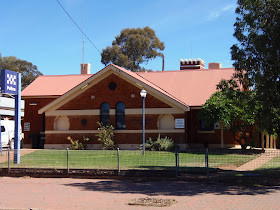Hooray, I've finally made it, a long and lonely 1000 kms from Broken Hill to "The Ridge". My first impression even as I headed through the Welcome Gate was that this is going to be a unique and intriguing experience. The Ridge to me had an instant feeling of an outback idiosyncratic difference to any other place that I had visited. I could describe it as a sense of lawlessness (which there isn't) or a place where all men come for only one reason, to strike it rich. Opal Miners are easy to pick either big burly blokes with long beards or old timers with their bow legs and a beaten up station wagon or ute. Most shops in only two major streets either sell food, opals, hardware and mining supplies or are closed down. I love this place already, hot, dusty and "Outback". A sign stating the population of Lightning Ridge as "?" sums up the mood and humour that I could identify with.
A Statue on the Hwy outside Lightning Ridge (The Body is a VW Beetle)
Lorne Station
I managed to learn that Opal contains every colour of the spectrum from deep blues to iridescent green through to golden orange, red and fuchsia. Opal can be pale and delicate or dark and brilliant. the colour can change as the observer turns the stone. Lightning Ridge is famous for the White and Black Opal and indeed produces almost all of the World's Black Opal, the rarest variety. Here, Opal is mined underground with mines usually extending to a depth of 25 metres. Open cut methods are used less in Black Opal country than in other Opal mining areas. Each Claim is a maximum size of 50 x 50 metres and a miner can have up to two Claims registered in his or her name. To begin mining, a shaft of about a metre in diameter is drilled to a level thought to contain Opal. A tunnel or "Drive" is dug searching for Opal along the way. "Opal Dirt" is taken to the surface, is washed for several hours in a modified Cement Mixer. Finally, the "tailings" are sorted for any hint or trace of Opal colour.
The uniqueness of this place really shines when I drive through the "Streets" of lightning Ridge. Really only short, dusty and potholed tracks that wind there way between Miner's Claims. This is still just a large Camp there is no building code, no houses really. Miners live in anything they can beg, borrow, steal or put together themselves. It could be an old caravan or bus, corrugated humpy or even just a tent and all dwellings are very, very basic. Amazingly almost every square metre has been mined with piles of Opal Dirt everywhere. it really is hard to describe.
An Historic Miner's Hut in Town
A couple of strange and again unique structures must be mentioned. My favourite was Amigo's Castle. An Italian now nicknamed Amigo by the miners, came here to find opal but was not really successful. To fill in his spare time he began to hand build his dream, a castle, by hand from local stone. he began in 1983 and continued until recently, never finishing his project. Amigo, has stopped working on his dream and at age of 61 lives nearby. he now has a new project though, Amigo has found an almost complete Dinosaur skeleton under his Castle and spends his time laboriously excavating. Another strange person built the Astronomy House which is a crazy dedication to histories great astronomers, I learnt. One more was ta house built from empty bottles, $10 to look inside...I didn't.
Amigo's Amazing Castle, each stone is hand cut and a perfect fit.
The Astronomy House
The Bottle House
A Club in the Scrub


























































